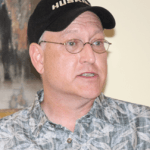New Policy Will Boost Restoration of Natural Resources
President Obama recently unveiled a new policy meant to foster wildlife and habitat conservation and encourage private investment in the restoration of natural resources that are affected by development. The presidential memorandum directs several federal agencies—the Departments of Defense, Interior, and Agriculture, as well as the Environmental Protection Agency and the National Oceanic and Atmospheric Administration—to adopt regulations that would mitigate the impact of development projects on the environment and offset any impact those projects have on wildlife and their habitats.
Released last month, the memorandum will likely have significant implications for birds and their habitats. ABC's Steve Holmer, Senior Policy Advisor, and Dr. Michael Hutchins, Director of the Bird Smart Wind Energy Campaign, say the new policy offers hope for preventing habitat loss on state and federal lands through smart planning and, when needed, compensation from developers. They took a few minutes to tell us more about this new approach to protecting critical natural resources—and the birds that rely on them to survive.
Q: The president calls on the agencies to have “clear and consistent approaches” to avoid and minimize the harmful effects of current and future development on land, water, wildlife, and other natural resources. Do agencies already do this?
Steve Holmer: No. This policy is a new way of doing things and is intended to help land and wildlife managers strike a better balance between development and conservation. It has the potential to ensure that public lands will always maintain viable habitats for wildlife, recreation opportunities, and ecosystem services that benefit society.

Development of natural resources has resulted in the loss of habitat for many birds, including the Marbled Murrelet. Photo by Mike Danzenbaker
We need this policy because under the current rules, we are losing irreplaceable habitats to development of all kinds. Sagebrush, areas along riverbanks, and mature forests are all affected. As a result, many bird species are now endangered or losing ground, including Northern Spotted Owls, Marbled Murrelets, Greater Sage-Grouse, western Yellow-billed Cuckoos, Golden Eagles, and Whooping Cranes.
Q: In the context of natural resources, what does mitigation mean?
Michael Hutchins: Mitigation in this context can take many forms, but in general, it simply refers to attempts to minimize or avoid negative environmental impacts from development. A developer can do one or more of the following to offset environmental harm: limit the degree of impact, repair or restore the affected resource, or compensate for the impact by replacing or providing substitutes for the affected resources.
In the wind industry, for example, this would include retrofitting power lines and towers to reduce collisions and electrocutions or shutting down turbines during peak migration. Companies could also buy and set aside key habitat for affected species in other suitable locations.
We also need to test various forms of mitigation to find out how effective they are. Until then, wind and solar companies cannot claim to know how to minimize wildlife impacts.
Q: From a practical standpoint, how does the federal government actually put these plans into practice?
MH: Mitigation banking is one way. It's essentially an environmental crediting system that state and federal governments establish. Companies incur debits when development damages a species or habitat; they gain credits when development enhances, repairs, or preserves that resource. This approach has been successful in mitigation for bird species such as the Greater Sage-Grouse and the Lesser Prairie-Chicken.

Mitigation banking is one approach that has helped restore natural resources for birds such as the Lesser Prairie-Chicken. Photo by Noppadol Paothong
Q: What are the implications for renewable energy companies?
MH: Unfortunately, today's wind and solar development kills and displaces hundreds of thousands, if not millions, of birds every year—including federally protected species such as such as Golden Eagles and Yuma Clapper Rails. The best form of mitigation is building wind turbines and solar facilities away from sensitive areas for birds and bats, and we haven't done a very good job of that so far.
Still, this memo will definitely affect the way these companies do business. Wind and solar companies are going to have to show that they are making the impact of their projects less severe. They are also going to have to allow the public to learn more about development projects that occur on public lands.
Q: Does the memo legally require companies to take part in this kind of mitigation? Or is it voluntary?
SH: Projects on federal lands must be fully mitigated, so for companies doing business on federal lands there will be requirements to avoid and minimize impacts or pay compensation. On private lands, mitigation will primarily be voluntary, except when listed species or species of concern are involved because they may be in compensation programs to conserve the species. The details for mitigation will be addressed as projects are planned.

The Yellow-billed Cuckoo is a declining species that could stand to benefit from President Obama's new mitigation policy. Photo by Paul Sparks/Shutterstock
Q: What does this directive mean for ABC's work in bird conservation?
SH: This policy is great news for birds that are losing their habitat on federal land. It's also going to help species that are being considered for federal protection under the Endangered Species Act because it will provide resources for their conservation and recovery.
Depending on how the mitigation policy is designed and implemented, it could greatly reduce a variety of threats to birds. And the compensation system—although still in development—could provide substantial resources to meet bird conservation needs. ABC is already working with partners on recommendations to the administration to help make this program as effective as possible for bird conservation.
Q: What bird species or ecosystems do you think stand to benefit the most from this approach?
SH: The Greater Sage-Grouse conservation plans allow for continued development in priority sage grouse habitat, provided that any impacts to grouse would be mitigated. As a result, this mitigation policy is critically important to making the grouse conservation initiative a success.
Northern Spotted Owl and Marbled Murrelet are two other birds that could be affected. They are currently losing habitat on federal, state, and private lands because of development that is not being mitigated—resulting in continued population declines. This policy could help to balance the conservation of these species with the extraction of natural resources.

The Northern Spotted Owl is losing habitat because of development that is not being mitigated. The new policy could help. Chris Warren
Q: So does mitigation solve the problem?
MH: Mitigation sounds good, because with it, we can presumably develop our natural resources and reap the economic benefits without destroying nature. But there is reason to be cautious. Mitigation is better than nothing, but whenever possible, it's better to protect and preserve functioning, viable ecosystems.
If this memorandum allows developers to proceed under virtually any and all circumstances—regardless of the consequences—then it will ultimately be a form of “greenwashing.” On the other hand, if it results in greater protection of wildlife and their habitats, then it will be a success.
Q: The directive takes on added significance in the wake of an announcement last week at the U.N. Climate Change Conference in Paris that the United States will take part in Mission Innovation, a joint effort by several countries to accelerate research and development in clean energy. How will these initiatives mesh with one another?
MH: It's too soon to tell. I'm happy to see our president taking global leadership on climate change. That said, when it comes to alternative energy, we need to minimize the impact on wildlife to the greatest extent possible. Wildlife should not be collateral damage in our war against climate change.
Let's focus our research on finding better ways to exploit and distribute clean wind and solar energy without killing vast numbers of birds and bats. We're not there yet, but hopefully the president's new policy on mitigation will move us in the right direction.
 Steve Holmer has more than 20 years of experience working to conserve endangered wildlife. He came to ABC from the Unified Forest Defense Campaign and previously served as Campaign Coordinator of American Lands Alliance working to conserve habitat for the Northern Spotted Owl and Marbled Murrelet. Steve directs the Bird Conservation Alliance, a network of over 200 conservation groups that builds congressional support for bird conservation programs.
Steve Holmer has more than 20 years of experience working to conserve endangered wildlife. He came to ABC from the Unified Forest Defense Campaign and previously served as Campaign Coordinator of American Lands Alliance working to conserve habitat for the Northern Spotted Owl and Marbled Murrelet. Steve directs the Bird Conservation Alliance, a network of over 200 conservation groups that builds congressional support for bird conservation programs.
 Michael Hutchins earned his Ph.D. in animal behavior at the University of Washington. He served as Director/William Conway Endowed Chair, Department of Conservation and Science, at the Association of Zoos and Aquariums for 15 years, and Executive Director/CEO at The Wildlife Society for seven years. He has authored over 220 articles and books on various topics in wildlife science, management, and conservation, and has traveled to over 30 countries to pursue his passion for conservation.
Michael Hutchins earned his Ph.D. in animal behavior at the University of Washington. He served as Director/William Conway Endowed Chair, Department of Conservation and Science, at the Association of Zoos and Aquariums for 15 years, and Executive Director/CEO at The Wildlife Society for seven years. He has authored over 220 articles and books on various topics in wildlife science, management, and conservation, and has traveled to over 30 countries to pursue his passion for conservation.


















































